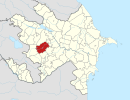| Vank Վանք | |
|---|---|
| Vəngli | |
 View of the village from the road between Vank and Gandzasar Monastery View of the village from the road between Vank and Gandzasar Monastery | |
  | |
| Coordinates: 40°03′28″N 46°32′44″E / 40.05778°N 46.54556°E / 40.05778; 46.54556 | |
| Country | |
| • District | Aghdara |
| Elevation | 1,031 m (3,383 ft) |
| Population | |
| • Total | 1,574 |
| Time zone | UTC+4 (AZT) |
Vank (Armenian: Վանք) or Vangli (Azerbaijani: Vəngli) is a village in the Aghdara District of Azerbaijan, in the region of Nagorno-Karabakh. From 1991 to 2023 it was controlled by the breakaway Republic of Artsakh. The village had an ethnic Armenian-majority population until the exodus of the Armenian population of Nagorno-Karabakh following the 2023 Azerbaijani offensive in Nagorno-Karabakh. The 13th-century Gandzasar Monastery, and the 9th-century Khokhanaberd fortress are located near Vank.
History

The village of Vank (meaning monastery in Armenian) was founded in the 9th century, and was named as such for its proximity to Gandzasar Monastery. Although the current structure of Gandzasar was built in the 13th century, a church or monastery existed at the site several centuries before then. The village was previously also known by the name Vankashen.
The village is surrounded by several historical monuments dating to the Middle Ages. The most prominent among them is the thirteenth-century monastic complex of Gandzasar (built from 1216–38), which overlooks the village and was built by the Armenian ruler of the Principality of Khachen, Prince Hasan-Jalal Dawla. Khokhanaberd, a 9th-century mountaintop fortress is also located near Vank, which served as a castle and residence of rulers of the House of Hasan-Jalalyan.
During the Soviet period, the village was a part of the Mardakert District of the Nagorno-Karabakh Autonomous Oblast.
In the years following the conclusion of the First Nagorno-Karabakh War (1988-1994), the village has seen an increase in investment from the Armenian diaspora. Levon Hairapetyan, a Russian-based Armenian businessman and a native of Vank, has funded the reconstruction of homes, the local school, and sponsored the building of a zoo, and the nearby Hotel Eclectica, which resembles a ship. In October 2008, Vank was also one of several venues in Nagorno-Karabakh for a mass wedding of 560 Armenian couples.
Historical heritage sites
Historical heritage sites in and around the village include the 12th-century church of Yeghtsun Khut (Armenian: Եղցուն Խութ), the 12th/13th-century monastery of Havaptuk (Armenian: Հավապտուկ), a 12th/13th-century cemetery, Gandzasar monastery (1216-1238), a 13th-century khachkar, a 13th-century village, and the medieval shrine of Yeghegyan Nahatak (Armenian: Եղեգյան Նահատակ).
Economy and culture
The population is mainly engaged in agriculture and animal husbandry. As of 2015, the village has a municipal building, a house of culture, a secondary school, an art school, a kindergarten, 18 shops, two hotels, and a medical centre. The community of Vank includes the village of Nareshtar.
Demographics
Vank had a population of 1,284 in 2005, and 1,574 inhabitants in 2015.
Gallery
-
The remains of Prince Hasan-Jalal's fortress of Khokhanaberd (on left), as seen from Gandzasar
-
Vank as seen from Gandzasar Monastery
-
 Hotel Eclectica in Vank
Hotel Eclectica in Vank
-
 Lion of Vank
Lion of Vank
-
 Entrance to the village
Entrance to the village
-
 Walls of Khokhanaberd, close by are the ruins of the monastery of Havaptuk
Walls of Khokhanaberd, close by are the ruins of the monastery of Havaptuk
-
 School in Vank
School in Vank
References
- ^ Hakob Ghahramanyan. "Directory of socio-economic characteristics of NKR administrative-territorial units (2015)".
- Андрей Зубов. "Андрей Зубов. Карабах: Мир и Война". drugoivzgliad.com.
- Sauer, Pjotr (2 October 2023). "'It's a ghost town': UN arrives in Nagorno-Karabakh to find ethnic Armenians have fled". The Guardian. ISSN 0261-3077. Retrieved 9 November 2023.
- ^ Hakobyan, Tadevos Kh.; Melik-Bakhshyan, Stepan T.; Barseghyan, Hovhannes Kh. (2001). Հայաստանի և հարակից շրջանների տեղանունների բառարան [Dictionary of toponymy of Armenia and adjacent territories] (in Armenian). Vol. 4. Yerevan: Yerevan State University Publishing House. pp. 759–60.
- Mkrtchyan, Shahen (1989). "Гандзасар ". Историко-архитектурные памятники Нагорного Карабаха (2nd ed.). Yerevan: Parberakan. pp. 14–19.
- Hewsen, Robert H. (2001). Armenia: A Historical Atlas. Chicago: University of Chicago Press. pp. 119–120. ISBN 0-226-33228-4.
- Mkrtchyan, Gayane (August 31, 2007). "A Wonder in Karabakh: A visit to the "mysterious" attraction of Vank". ArmeniaNow.com. Archived from the original on March 20, 2012. Retrieved June 14, 2013.
- Sargsyan, S. S. (1996). "Խոխանաբերդ. նորահայտ վիմագրեր Խաղբակյանների մասին" [Khokhanaberd: newfound inscriptions about the Khaghbakyans]. Lraber (in Armenian). 3: 96–105. Retrieved 17 January 2021.
- Hakobyan, Tadevos Kh.; Melik-Bakhshyan, Stepan T.; Barseghyan, Hovhannes Kh. (2001). Հայաստանի և հարակից շրջանների տեղանունների բառարան [Dictionary of toponymy of Armenia and adjacent territories] (in Armenian). Vol. 2. Yerevan: Yerevan State University Publishing House. pp. 764–65.
- "Holidaying in lands that don’t exist: Artsakh." The Focus. May 24, 2020. Retrieved May 25, 2020.
- Noble, John et al. Georgia Armenia & Azerbaijan, 3rd ed. Oakland, CA: Lonely Planet, 2008, p. 306.
- Hayrapetyan, Anahit. "Nagorno-Karabakh: Mass Wedding Hopes to Spark Baby Boom in Separatist Territory." Eurasianet. October 23, 2008. Retrieved November 11, 2010.
- "The Results of the 2005 Census of the Nagorno-Karabakh Republic" (PDF). National Statistic Service of the Republic of Artsakh.
External links
- Musaelian, Lusine. "A Taste of China in Karabakh." IWPR. CRS Issue 408, September 5, 2007.
- Gandzasar.com: Gandzasar Monastery, Nagorno Karabakh Republic
- (in Armenian) The Hasan-Jalalyans, Charitable, Cultural Foundation of Country Development.
- Vank, Nagorno-Karabakh at GEOnet Names Server
| Martakert Province | ||
|---|---|---|
| Capital: Martakert | ||
| Urban communities |  | |
| Rural communities |
| |
| Not under Artsakh control | ||
